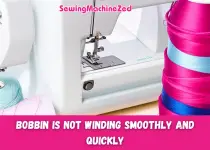Why Is My Sewing Machine Needle Not Moving?
Sewing machines are a great way to make yourself look professional and get the job done quickly. But some common problems can arise when sewing and one of them is a stuck needle. If your needle isn’t moving up or down correctly, read through!
Quick Fix
If your sewing machine needle is not working, you can try a few things. First, ensure that the machine has power, that the thread is correctly threaded, and that your device isn’t set to fill the bobbin.
If those steps don’t help, then try out these:
- It could be something as simple as a broken needle clamp screw or a bent shuttle race. In this case, you can remove any thread from that area to pull out any fabric that might get caught up in it while trying to fix it.
- The next step would be to remove any thread from the shuttle race preventing the needle from working correctly; this will vary depending on how bad your problem is!
For a detailed guide, continue reading!
Broken Drive Belt On Sewing Machine
The most common reason for a broken drive belt on a sewing machine is that it has been stretched or worn out. A worn-out drive belt can cause issues with your machine because it may not be able to move the needle correctly, which could result in poor stitching and uneven seams.
If you notice that your sewing machine’s belt has become frayed or damaged, look at our guide on how to replace a sewing machine’s drive belt before attempting any repairs yourself.
Disengaged Clutch
The needle is not moving because the clutch has disengaged. This can happen in several different situations, such as if you turn the machine on and off or have not used it for a while.
The clutch is located on the bottom of your sewing machine, next to where it attaches to its drive belt. It’s spring-loaded and releases when turned by hand or pressed down with a foot pedal (depending on which model you have).
If your sewing machine has this problem, try turning it off and back on again. If that doesn’t fix things, take apart your machine for inspection; something might be wrong inside!
Internal Drive Gear Failure
If you have a sewing machine that is not moving, it could be because of the internal drive gear. This part drives your needle and feeds fabric through the machine.
The internal drive gear can break, become misaligned, or missing. You may also notice that it’s worn out and needs to be replaced.
Thread Caught in Shuttle Race
If your needle isn’t moving, the most likely culprit is a piece of thread caught in the shuttle race.
To start with: if it happens again, ensure you do not have any foreign objects like pins or needles in your machine! Next time you turn it on and get ready to sew your project, check for anything stuck or lodged between the shuttle and bobbin case.
Watch this video if you are struggling with this!
The Thread Has Become Entangled Around the Spool Pin or Thread Guide.
If your sewing machine is not moving, there are several potential causes. Some of these are related to the thread and needle, while others may be related to other parts of your machine.
The most common cause is that the thread has become entangled in one or more of the following areas:
- Spool pin or thread guide (if you have a lock stitch)
- Shuttle race (if you have a feed dog)
- Bobbin case (if it’s an old machine)
Internal Drive Gear Failure
The most common cause of the needle not moving is the internal drive gear failure. This can happen when a thread gets caught between two of its gears or if there’s too much tension on your sewing machine hook. You’ll have no control over where your needle goes next and what thickness of thread it picks up.
The good news is that fixing this problem isn’t hard at all! All you need to do is get out some pliers, unbuckle the hook from its rails (if necessary), disconnect it from any other components like belts or motors, and pull off any excess threads from around their ends (you may want to take pictures first), then use an adjustable wrench with an open jaw on one side only—and voila! Your machine will start working again like new!
The Upper Thread Tension is Set Too High or Too Low.
The first thing to check is the upper thread tension. Your needle will not move properly if it’s too high or too low. You’ll need to adjust this setting so that the needle moves smoothly and reliably when sewing.
If you’re having problems getting your machine to sew correctly, try adjusting its upper thread tension so that it matches what you see in this picture:
The manufacturer recommends a maximum setting for their machines; if yours has one of those settings (or even if it doesn’t), then try setting yours at that point, as well as another issue between the minimum and maximum settings.
Wrong Needle Size for Your Project

You probably know that your sewing machine needle size is based on the fabric you’re using, but did you know that it’s also based on the type of thread?
The same goes for different stitches: some require more tension than others; therefore, their respective sizes are designed accordingly.
The wrong needle size can cause your machine to skip stitches, but it’s not the only thing that can cause this issue. If you’re using thread that’s too thick or too thin for your sewing project, that might be causing your problem.
The Bobbin Case Fell Out.
If the bobbin case falls out, your sewing machine will not work. To fix this problem:
- Please turn off the power to your machine and unplug it from the wall outlet.
- Remove all parts inside your machine, and keep track of them as you remove them so they don’t get lost or damaged while you work on their replacement.
- If there are no tools available for removing any screws or other fasteners holding parts in place (elevator bar), use a flathead screwdriver along with pliers to pry them apart gently until they come free enough that you can pull them out without damaging anything else being held by them at the same time.
Conclusion
If you are still struggling with this problem, let us know! We will get back to you as soon as possible!



